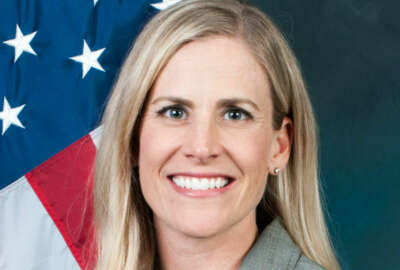VHA still needs more accurate reporting of staffing numbers
Department of Veterans Affairs reform legislation back in 2018 required the Veterans Health Administration to report regularly on its staffing and vacancy levels.
Best listening experience is on Chrome, Firefox or Safari. Subscribe to Federal Drive’s daily audio interviews on Apple Podcasts or PodcastOne.
Department of Veterans Affairs reform legislation back in 2018 required the Veterans Health Administration to report regularly on its staffing and vacancy levels. VHA officials generally meet the requirement. Now the Office of Inspector General has found that VHA has made a lot of progress in the accuracy of its reporting but still has a ways to go. Federal Drive with Tom Temin got more now from Deputy Assistant Inspector General Leigh Ann Searight.
Interview transcript:
Tom Temin: Veterans Affairs reform legislation back in 2018 required the Veterans Health Administration to report regularly on staffing and vacancy levels. VHA officials generally meet the requirement. But now the Office of Inspector General has found that VHA has made a lot of progress in the accuracy of its reporting, but it still has a ways to go. We get more out from Deputy Assistant Inspector General Leigh Ann Searight,. Ms. Searight, good to have you back.
Leigh Ann Searight: Thank you, Tom. It’s great to see you. Again.
Tom Temin: I want to get to the bigger picture later on of how this issue affects their ability to actually fill the vacancies. But what you were looking at was not that specifically, but rather how accurate they know what is going on with their vacancies? Is that a fair way to put it?
Leigh Ann Searight: Yeah, so as part of the 2018 mission act, VA was required on a quarterly basis to publish their vacancy and staffing information. And also, as part of that act, the inspector general’s office was asked to review that and provide recommendations for improvement. So we’re now on our third report and looking at this information. And really what we saw through this is, like you said that VA has made some improvements. However, the accuracy of the information, the staffing information, they acknowledge, and they’re working to improve that. And so we were trying to look at that and see how off they are. And so you know, that transparency and reporting of that information really does still need to be improved.
Tom Temin: Because where you look around at VA and VHA, they have multiple systems for lots of things. Is the multiple instances of personnel systems part of the issue here?
Leigh Ann Searight: No, actually, HR Smart is the single solution within VA. It is the enterprise HR solution. So they used to use a system called the paid system. And in 2016, June of 2016, they moved to HR Smart. Now there’s been, you know, maybe a slow movement to that, but they are fully under HR Smart. And they’re still working to clean that up and sort of change their HR staff’s processes from what they used to do under paid, which was more of a faces management, whereas HR smart is a spaces management system.
Tom Temin: Okay, and what’s the difference between spaces and faces?
Leigh Ann Searight: Well, the difference is that if I hired you into VA, under HR Smart, I would be able to manage your position, what position I hired you in. And it wouldn’t matter whether you were in that position, or I was in that position. So then if you took a new job at another VA, I can move you into a different position, and all your records transfer with you. But I have a better picture of what I’m managing at that specific facility, versus knowing I have Tom on my roles, I now just know that I have that vacancy filled,
Tom Temin: But can either way, and I guess we’re talking about HR Smart now, because that’s the one they use, there’s no button they can push this to get a nose count in VHA?
Leigh Ann Searight: So there is a button that they can push to get that nose count, but the data in the system that that button replicates, essentially, is not correct. So they have still vacancies and positions identified in HR Smart that really are not valid position. They’re either not funded; they were not fully approved. So getting an accurate count of how many positions are truly vacant, and what VA can truly afford to fill, is still in the works.
Tom Temin: Got it. So they have basically a data problem more than a systems logic problem, it sounds like.
Leigh Ann Searight: Exactly, exactly. So what we found was under the paid system, when you hired somebody, they would create that line item essentially for you. And under HR Smart, they’re still trying to do that process. And so that makes it you’re duplicating, essentially. So if I hired you, I put you in for that position, and then maybe you got a promotion. But instead of moving you and keeping the physician, they replicate that so it looks like you have two people instead of one.
Tom Temin: In other words, someone was deputy chief of surgery of nose jobs at a VISN. And then they were promoted to chief of surgery of those jobs at that same VISN, they would be in there twice.
Leigh Ann Searight: Right. And then whoever you hired to replace them would be in there again. So it just started to duplicate and maybe triplicate positions.
Tom Temin: Got it, you might say that HR Smart is a two faced system or a multiple face system. We’re speaking with Leigh Ann Searight, deputy assistant inspector general at the Veterans Affairs Department. And so in looking at this vacancy report, as required by Congress, then, was it total nonsense or was it off by 5%? What was the result of this data problem that they have?
Leigh Ann Searight: Well, the data problem is still fairly significant. I couldn’t give you a specific percentage, but just since the end of FY ’20, the VA has identified over 22,000 positions that they have removed from the system. And they tout that VA has over 370,000 people working within VA. So that gives you a little bit of a perspective. And they’re still working, so there’s still positions to be reduced.
Tom Temin: And the bigger question here then is — they need to get their data straight and harmonize and all of this — but does this hinder their ability to fill the positions? Which I think that’s the intent of the legislation in the first place, ultimately, is to make sure that all the vacancies are filled so that they can fulfill their mission.
Leigh Ann Searight: Right, I don’t think it hinders our ability to fill the positions necessarily. What it really hinders their ability is to really identify what the true need is, and to be able to support themselves as they go forward to Congress to say where I really have a capacity need or a capability need.
Tom Temin: So as, say, the medical requirements of the constituency they serve changes, say it’s aging, you might need different types of people to be in VA to be able to help what it is that’s the reality of the people you’re serving. And so it may be difficult for them to plan and do a strategic approach to HR? Would that be a good way of putting it?
Leigh Ann Searight: Yes, I would agree with that. I mean, what we’ve found in VHA is that, you know, you have 140 different VHA systems out there in terms of hospitals, and 140 different ways of how they manage HR. Now they’re doing a massive consolidation and putting that under 18 VISNs instead of each individual facility. But what we saw was one facility might manage physician transparency through organization charts, and some of those organization charts were very dated. And then another might do it a different way. And so you really did not, and still don’t, have a really consistent picture of what each facility truly needs versus a like to have versus an actual need.
Tom Temin: And then summarize for us your recommendations. What do they need to do to get around this big data problem?
Leigh Ann Searight: So our recommendations really focus on improving the transparency and the governance of those positions. So one, still working towards cleaning up their data. And then two, developing some policies that actually apply consistent practices and how they manage human capital, how they report vacancies, how they build their organization charts, what they put into HR smart in terms of encumbered or non encumbered positions.
Tom Temin: And do they generally agree with the recommendations? They know this has got to be an issue.
Leigh Ann Searight: Yes, they do agree with the recommendations. And really, their response to that is they have an action plan in place, they’re trying to move that forward. COVID put a little bit of a wrinkle in that process for them. However, they are, you know, intent on cleaning this up.
Tom Temin: And cleaning up that data — Is it a manual process, like face by face or body by body? Or is it something that they can do in an automated fashion by de-duping data sets?
Leigh Ann Searight: I think it’s a little bit of both. I think one, you have to go through each organization and sort of identify position by position, whether it’s a valid position or not and unnecessary. And then is it aligned to the right person? And then I think you could probably identify some of the duplication through data polls.
Tom Temin: Leigh Ann Searight is deputy assistant inspector general at the Veterans Affairs Department. Thanks so much for joining me.
Leigh Ann Searight: Thank you, Tom.
Copyright © 2025 Federal News Network. All rights reserved. This website is not intended for users located within the European Economic Area.
Tom Temin is host of the Federal Drive and has been providing insight on federal technology and management issues for more than 30 years.
Follow @tteminWFED






